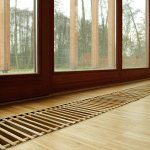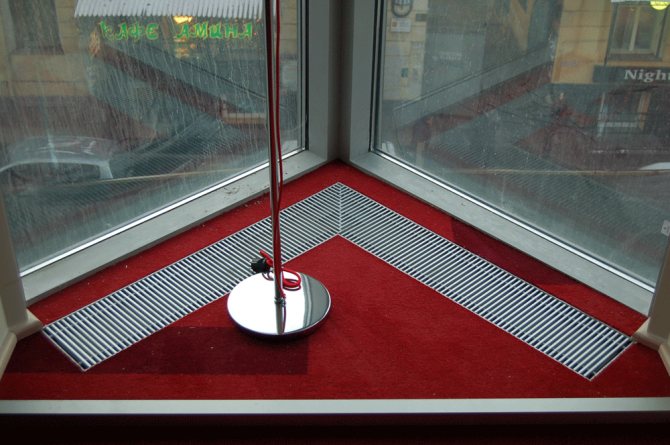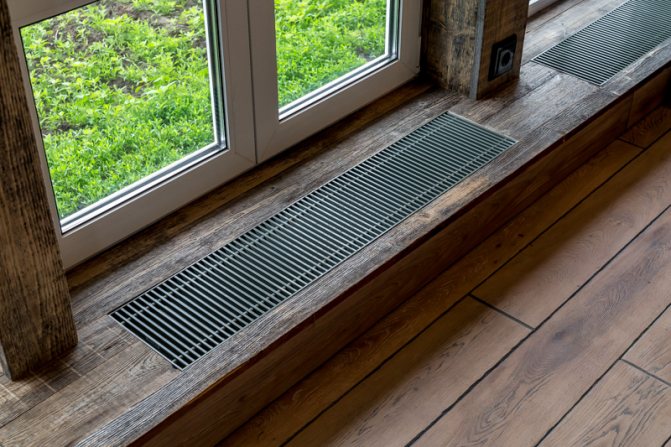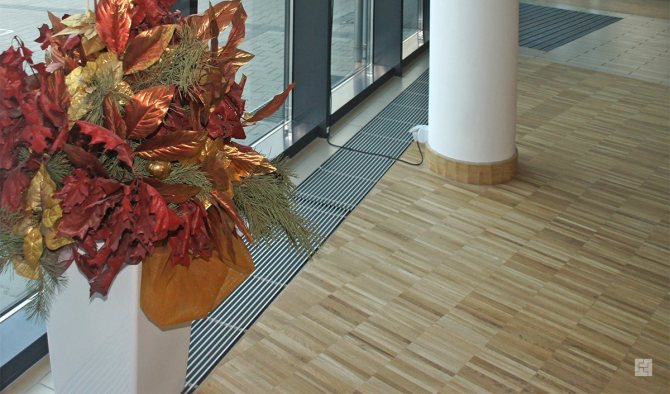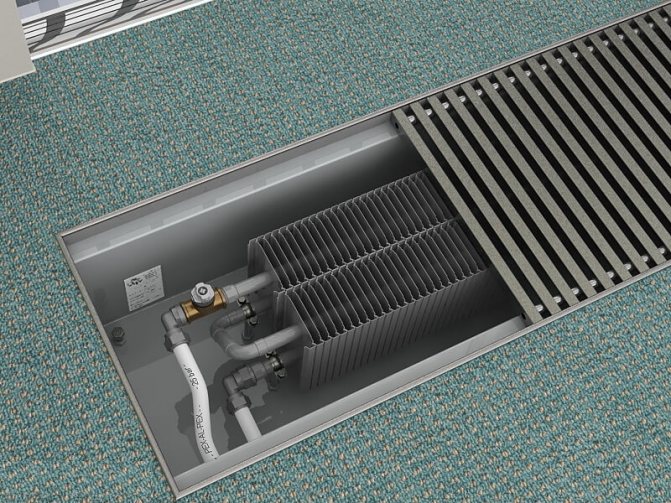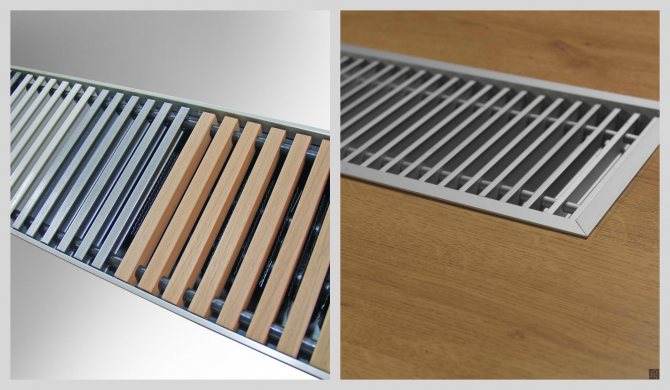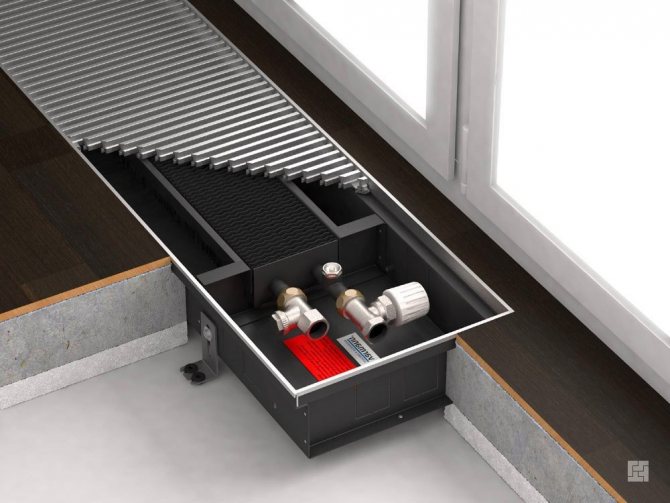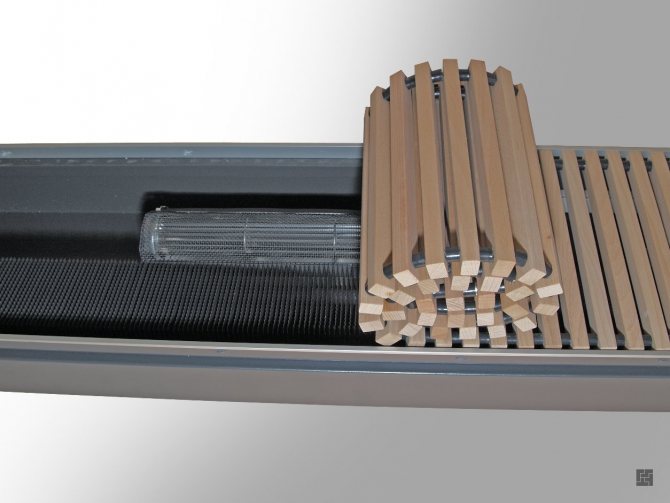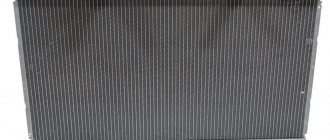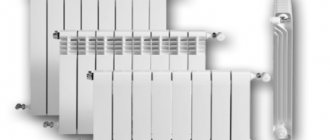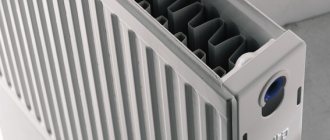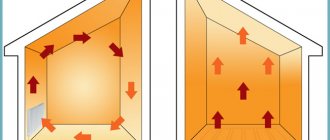Floor heating radiators are more often used for non-standard designs. In rooms that have panoramic windows, such batteries perform their functions without obstructing the open space. They not only heat the room, but also create a thermal curtain, preventing the flow of cold air from the windows. Such devices are installed in private homes, conservatories, gyms, offices and other social premises.
Floor heating radiators
Outwardly, such a radiator looks like a pencil case, closed on top by a grill. Inside there is a device that directly heats the room. Let's take a closer look at heating radiators built into the floor, their advantages and disadvantages in use.
Radiator device
Heating radiators built into the floor consist of a finned heater, a body and a panel covering the entire structure. They can be supplemented with fans for better heat distribution. The device is placed in the screed and embedded at the level of the floor covering.

Installation of radiators built into the floor.
Let's consider each element separately:
- The body of such a radiator is usually made of stainless steel. But for a dry room, you can pick up other material. The catch is that little-known companies often use low-quality technical steel, short-lived in operation. Be sure to ask the seller what material the case is made of.


Installation of radiators built into the floor.
- Finned heater or heat exchanger. It is a metal circuit with attached plates, chemically soldered with silver molecules. The plates are tightly connected to the base. Neither elevated temperatures nor the constant change in state as a result of expansion-contraction affects the bond strength. Heat from the circuit is transferred to the plates, from which heat exchange with air occurs.
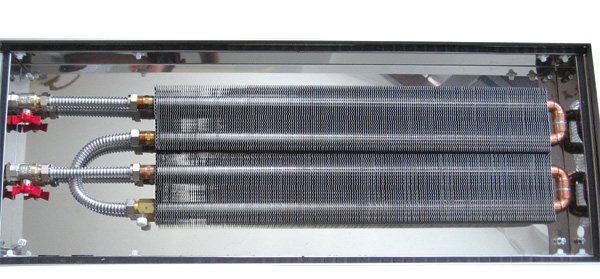

Finned heater
- Floor grilles. They are installed at the level of the topcoat and are intended to protect the structure from mechanical damage. They can be both removable and mounted together with the main radiator mechanism. The second option is sold ready for connection.
- Air fan. Installing a fan allows you to get more heat. It is connected to electrical networks, and vibration-proof supports are used to reduce the noise level. Radiators with existing fans generate more heat, as they block the cold air flow from the windows and prevent water droplets from forming on the glass.
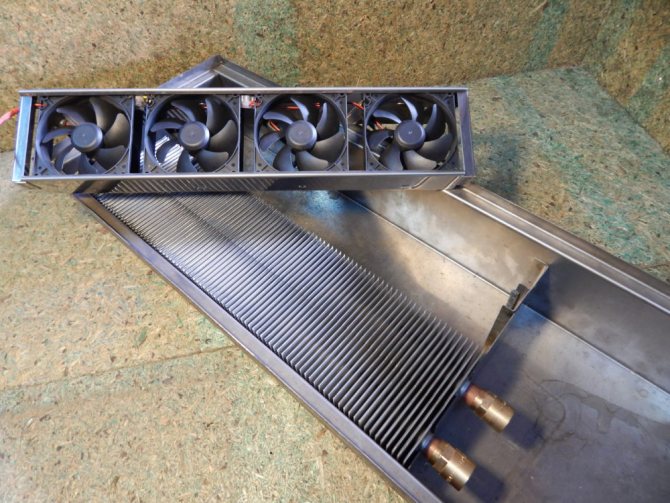

Air fan
- Dump valve. The device for dumping the air gap is connected after the installation of the radiator built into the floor. Helps to eliminate air bubbles and increases the efficiency of such a heating system.
- Regulators. The presence of such devices allows you to set the desired temperature in the room.


Regulators
Note! Almost all underfloor heating radiators have a power regulator. You can select the heating level at any time.
- Inputs. Located at the end or side of the radiator. If it is impossible to use a hot coolant, electric batteries are purchased, which are also built into the floor.


Inputs
Radiator in the floor - an innovative solution for organizing heating
A floor heating radiator is a heat-generating equipment, thanks to which it is possible to arrange a heating system without visible technical elements. The design of the device is relatively simple. It is a stainless steel box with copper-aluminum heat exchangers inside. For connection to other elements of the system, corrugated pipes made of materials resistant to corrosion are used.
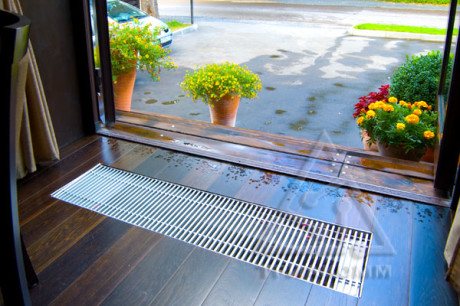

External view of the underfloor heating radiator
The principle of operation of floor convectors
Air heating is carried out using convection, therefore such heating devices are most often called built-in convectors. Cold air goes down through the grate, heats up and rises up. There are models with fans and those in which convection heating is carried out naturally. Devices with fans are more efficient, they warm up the air in the room faster due to the forced mixing of warm and cool layers of the air mass.
Instrument grilles are made of metal or wood, painted with persistent paints of various colors. Their temperature during the operation of the radiator does not exceed 30 degrees, which excludes the possibility of accidental injuries and burns.
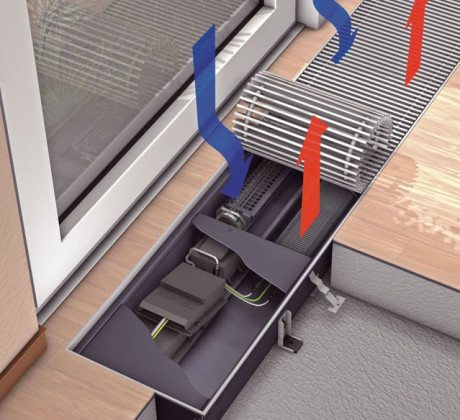

The design and principle of operation of floor-standing built-in heating radiators
Where are the floor models installed?
Built-in heating radiators are universal. They are installed in premises for any purpose - residential, office, commercial. They are appropriate everywhere: in private houses with French windows, shops, galleries, museums and even greenhouses. Floor devices are successfully used for heating rooms where there are special requirements for the microclimate.
There are models with additional features such as condensate drain function. Automatic systems regulate the operation of devices. Models with programmable thermostats allow you to set the desired temperature in advance.
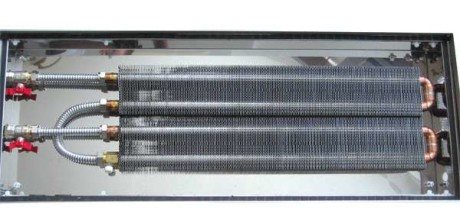

Exterior view of the underfloor radiator model with the decorative grille removed
Advantages of radiators built into the floor
Heating batteries built into the floor perfectly cope with the task of heating premises. Main advantages:
- The appearance of free space. Now nothing prevents you from placing interior items and furniture on the floor close to the wall.
- Concealed placement of the radiator. There is no need to buy appliances that match the design of the room.
- High performance of such a radiator with a long service life.
- Resistance to aggressive coolants, its reliability and compliance with all environmental safety requirements.
- Possibility of installing panoramic glazing.
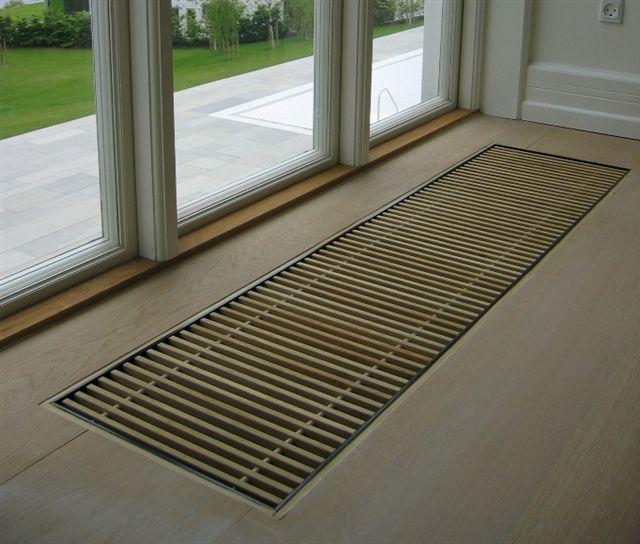

Floor mounted heating radiator
With all the positive qualities of heating radiators built into the floor, there are moments that reduce their popularity. For example, it is best to install these devices during the construction of a house or its overhaul. And batteries are connected with water as a coolant using a channel that is laid inside the floor. This makes installation difficult, especially if it is done in a cement screed.


Installation of a heating radiator built into the floor
Classification
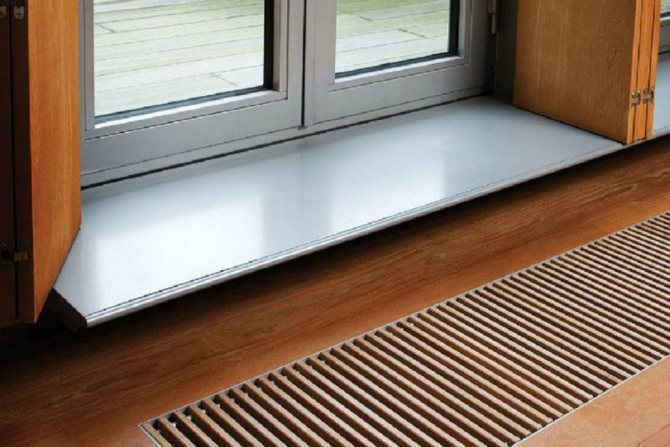

Wooden decorative radiator grill
The most popular among floor-mounted radiators with floor installation are water-based. Their main technical feature is the mandatory connection to the common house water supply system. They differ from electrical ones in much higher performance and low costs. A lot of domestic manufacturers offer reliable products of this kind.
They are classified according to the following parameters:
- Design.By design, radiators of this type can be with a case and in an open-frame design, when the heat exchange element is simply connected to the central heating system, mounted in the floor and covered with a grill. In this case, additional thermal insulation is made in raised floors or niches to eliminate heat leaks through the floor.
- Materials. The housing is always made from conventional stainless steel with excellent thermal conductivity characteristics. The heat exchange element in the budget version is also made of steel; in more advanced cases, more productive and expensive heat-conducting metals and alloys, such as copper, aluminum or brass, are used. The second positive property of non-ferrous metals used in the manufacture of convectors is their strong resistance to corrosion.
- Design. The original style of manufacture and various options for covering the body are regulated only by the modern capabilities of the metal industry and the wishes of the client. Currently, domestic and foreign manufacturers are putting on the market a huge range of heating equipment. It should be noted that the main attention should be paid to the "visible" part of the radiator, that is, the decorative grille that hides the radiator in the floor recess.
Features of radiators
- Floor heating devices are available with or without enclosures. The former are easier to install. First, a gutter is prepared along the length of the radiator, the device is placed in it and connected to the communications. The sizes of the boxes can range from 90 cm to 3 m, and allow you to choose the right option for any room.
- If you choose a simple and budget option without a case, you will have to choose a way to securely attach the battery to the floor and make thermal insulation in order to avoid heat loss. Almost any material sold on the construction market that is resistant to heat and has a low coefficient of thermal conductivity can be suitable as such a material.
- The simple design of the heat exchanger, consisting of a circuit and plates, is reliable and efficient in operation. It is available in galvanized steel, aluminum and copper. The latter options are more expensive and have better power ratings due to the high degree of thermal conductivity and corrosion resistance.
- There is a possibility of increasing the power. If the existing unit is insufficient to heat the room, the radiators can be equipped with an additional heat exchanger. The heated area increases 2-3 times.
- You can choose your favorite floor grille design. It can be made from different materials and have a different color scheme.


Various designs of grille built into the floor
Floor-mounted radiators work in the same way as conventional wall-mounted heating devices, but they also have their own distinctive characteristics.
Main characteristics
Floor-standing radiators are heat-generating equipment that is installed so that no technical elements are visible. The design of the radiator is quite simple and is a box made of stainless steel. Inside it has heat exchangers made of copper and aluminum. To connect in-floor radiators, corrugated pipes made of corrosion-resistant materials are used. A distinctive feature of the device is that there is no gap at all between the plates and the contour.
Such designs are available with and without housings. Both options are pretty easy to install. Before installation, you need to prepare a gutter corresponding to the length of the radiator. Then the device itself is placed in it, and only after that the radiator is connected to the communications. Radiator sizes range from 90 centimeters to three meters.This allows you to choose an option that will fully match the selected room. That is, he will be able to fully heat it, and at the same time will not take up too much space in the room.
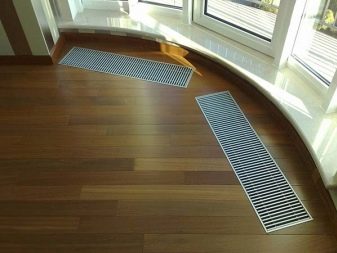

How to choose
When buying electric underfloor heating radiators built into the floor, you need to build on the required dimensions and the desired power. It is worth deciding with the fan: whether forced convection is needed or will it be enough natural.
When choosing built-in batteries with thermal fluids, many factors must be taken into account.
- Heating system pressure. Such radiators are suitable for heating houses with a closed heating network. Before installation in apartments of a multi-storey building, it is necessary to take into account the existing pressure. Such data can be obtained from the housing office or employees of the management company, and according to them, select the desired radiator model. Typically, such a device must withstand pressures up to 15 atmospheres.
- Parameters and type of coolant. If appliances built into the floor are mounted in a private house, then any coolant is suitable, since the owner of the home himself controls its temperature and condition. For residents of high-rise buildings, filling radiators can create many problems. Therefore, when deciding to install built-in batteries, you need to know in advance about the quality, Ph of the liquid, temperature, oxygen content and other characteristics of the coolant.
- Heating system type and connection diameters. Many models of radiators can function normally in one-pipe and two-pipe heating systems. But this information needs to be clarified with the sellers. And if the diameters do not match, you can use adapters.


One-pipe and two-pipe distribution of the heating system.
Note! Floor radiators can be the only sources of heating in a room.
Low floor heating radiators
Low heating radiator in the room.
If the windows in the room are made in the version when there is a small distance between the floor and the window sill, for high-quality heating, batteries attached to the floor can be mounted. Their use in cold climatic conditions will prevent the formation of ice on the glass, provide comfort and warmth. Such elements of the heating system have the necessary technical characteristics, have various dimensions, and differ in design.
An electric floor heating radiator can be selected for installation when the room is not connected to a central heating system; it is successfully used to heat rooms in country houses as an alternative to wood stoves. Floor radiators for water heating are mounted as an element of the heating structure of a private or apartment building, another room.
Floor mounting for heating radiators is necessary when the room has special characteristics - its walls are made of plasterboard, thick plywood, foam blocks or plastic. Such elements are not able to reliably hold the fasteners of conventional batteries, which can lead to spontaneous, sudden dismantling of the heating.
As a material, manufacturers use cast iron, aluminum, stainless steel and bimetallic alloys. The heat transfer of the device is increased by the built-in fans, they can be used at the request of the consumer.
What is considered when installing floor radiators?
The radiator is installed in the shopping center.
Underfloor low water heating radiators are required to be built into the existing system. A prerequisite for starting work is a complete drain of water Before purchasing a product, it is recommended to consult with heating specialists and discuss important parameters with them:
- indicators of working pressure inside the heating system;
- technical characteristics that the coolant must have;
- compliance of the diameters of pipes and elements for connecting the product itself;
- features of air humidity in the room, chemical characteristics of water used for heating.
For electric heaters, the most important characteristic is their power, then the buyer evaluates the external design.
There are two ways to install the battery - when the convector is directed towards the window or deployed into the room. The choice of installation features determines the purpose of the room. For example, if a floor-standing battery is located at a shop window, an exhibition hall, it is important to ensure that the glass does not freeze, to exclude the formation of condensation. In a living room, it is important to direct a stream of warm air inward. If desired, the convector can be turned off.
To install any type of structure, a floor bracket for a heating radiator is used. Such an element provides stability, safety, is required to prevent excessive heating of the floor, and protects the flooring from damage.
Read: what features an infrared heater with a thermostat has.
Find out how to insulate windows for the winter.
We advise you to find out what materials are better for thermal insulation of the bath.
Varieties of models
Two modifications of radiators are produced: with natural and forced convection. The available fans are powered by a 22 V mains or a 12 or 24 V DC source.
Among the variety of built-in batteries, models are sold that are designed for both heating and cooling. Two-pipe and four-pipe devices are available. In the first version, the heat exchanger is connected to heating and cooling. In the second, there are two heat exchangers, each of which is connected to one of the systems. Such radiators are more efficient in operation, but they are also more expensive.


Non-standard types and sizes of radiators.
There are floor-standing models with a fresh air supply function. To do this, air is sucked in through a separate hole, passes through built-in filters, heats up and goes back to the rooms.
For non-standard rooms with an existing curvature of the floor, you can order corner radiators or with the required radius of curvature. There are heat exchangers on flexible hoses that allow you to take the device out to the floor and put it back.
Electronic and mechanical thermostats allow you to control and change the temperature and power of radiators built into the floor. Such devices are located inside the case, and are controlled using a remote control. Electronic versions have the ability to program the heating temperature over time.


Radiator thermostat
You can also select devices designed for high humidity levels. In such radiators, materials and electrical equipment are used that do not lend themselves to corrosion. There is also a drainage outlet through which the condensate is discharged.
The device and principle of operation of floor convectors
The device of the underfloor convector heating Breeze is designed for installation of the system in the floor so that the device is out of sight. At the floor level, there is only a decorative grille that lets the warm air flow upwards. Structurally, the product can be installed in a small ledge laid along the wall of the room. The height of the product is in the range of 80 - 120 mm with a width of 200 - 380 mm, depending on the number of heat exchangers laid inside from a copper pipe with aluminum plates to enhance the effect of heat transfer.
The floor water convector works as a source of warm air that rises from the heat exchanger and moves along the wall of the room or translucent structure. Thus, the effect of uniform heating of the surface and distribution of heat throughout the room is created.To increase the efficiency of heating, a water floor convector equipped with fans for forced air mixing can be used. Depending on the model, the device can be equipped with a different number of fans.
Installer recommendations
The first important step after deciding to install this type of radiator will be to draw up a project indicating all the factors: location, dimensions of the structure, performance and the rest.
It is required to purchase all the necessary equipment.
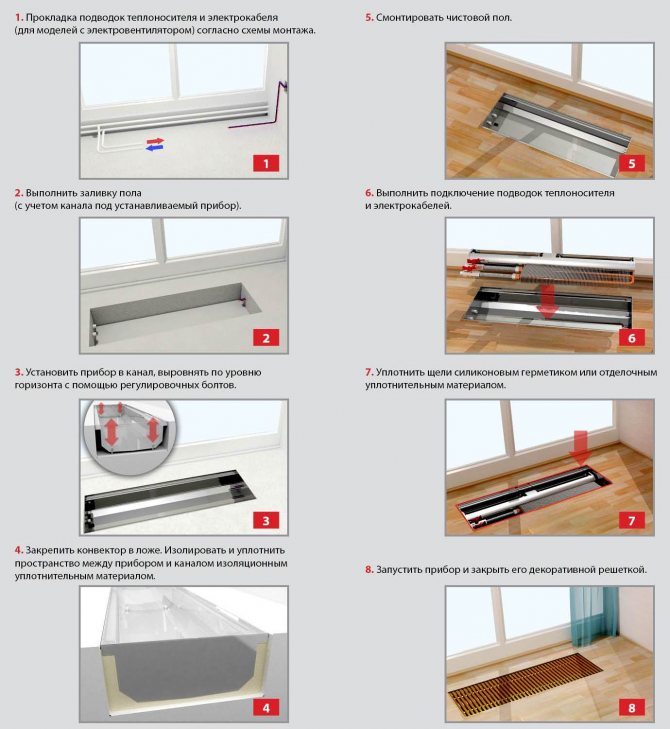

Installation of underfloor radiators
During the pouring of the screed, pipes are laid to supply the coolant. And in the finished room, grooves are made, into which the pipes will be placed. Next, a niche for the case is being prepared. At the same time, it should be larger than the radiator box by 5 mm in width and length with end connection, and by 10 mm with side connection. After that, the heating radiator is installed. At this stage, the main thing is to position the structure so that it does not protrude beyond the surface of the floor covering. The branch pipes are connected to the coolant supply pipes. The connection points must be firmly fixed. For verification, a test run of the heating system is usually carried out.
The final touch is to lay the outer grille on the floor.
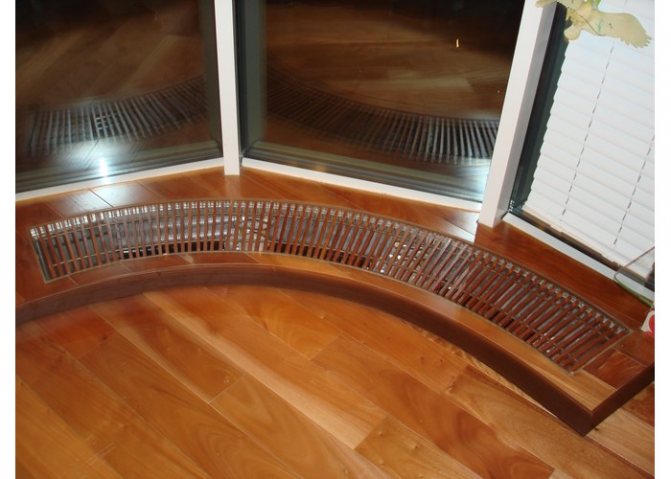

Radiator built into the floor
The calculation of the power and size of the device built into the floor is carried out according to parameters that take into account the height of the ceilings, the size of the windows, the average air temperature in the winter of the windows, and so on. Approximately selected in this way: for 1 square meter of area - 100 W of battery power.
Benefits of underfloor and floor heating systems
When operating radiators installed inside the floor and floor structures, their advantages are noted:
- the ability to use large panoramic windows or showcases in the design of premises in areas even with cold winters;
- high-quality maintenance of the required microclimate during the autumn-winter period;
- high performance of the device, its long service life;
- creating a unique interior, saving space.
An important feature of floor and hidden elements of heating systems is that they are absolutely invisible or have an "unobtrusive" appearance, while having all the necessary technical characteristics.
disadvantages
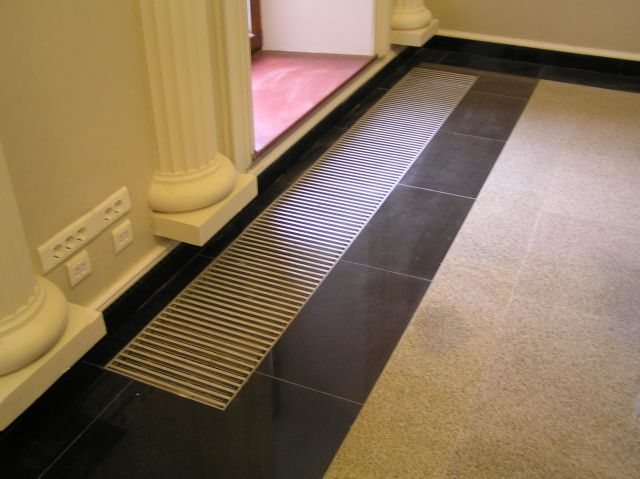

Floor convectors.
- The installation of such batteries may require an increase in the floor height. This will reduce the height of the room and will require additional costs for the purchase of building materials.
- The price of heating devices is higher than that of the usual wall or floor models.
- Such batteries are not the best option for rooms with a ceiling height of more than 3 meters. It would be better to purchase wall options.
- Floor recessed batteries are more difficult to install.
- If the radiators have a forced convection system, then the electricity charge increases.
- Dust collects inside the batteries, and if there is forced convection, it can spread throughout the room.
Installation features
Floor convectors can be installed in two ways: with a convector to the glass and to the room.
If the convector is turned towards the window, cold air will be effectively cut off, and the absence of condensation is guaranteed. But the room will warm up more slowly - a lot of heat is spent on heating the glass. But in the room there is a uniform temperature: cold and warm masses are mixed evenly.
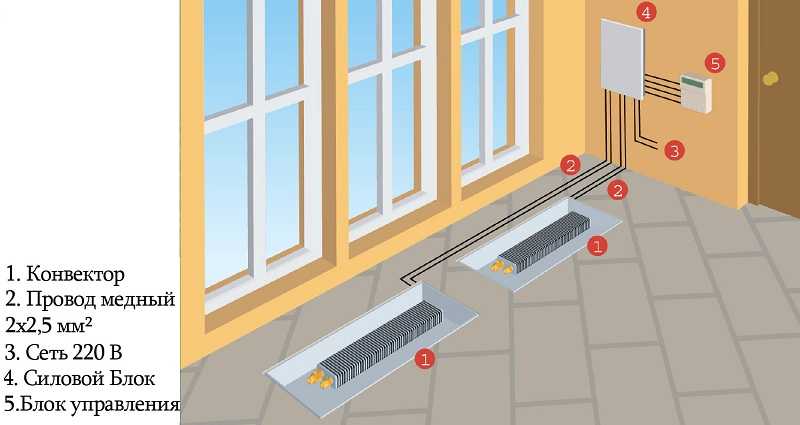

Underfloor heating installation diagram
Expanding the convector towards the room, we get fast heating. However, condensation may form on the glass. In addition, there are zones with different temperatures in the room, which is uncomfortable.
In-floor heaters are installed in prefabricated floor gutters.If the floor is concrete, the distance between the body and the walls of the gutter is filled with mortar; when installed in a wooden floor, a frame of beams is made around.
